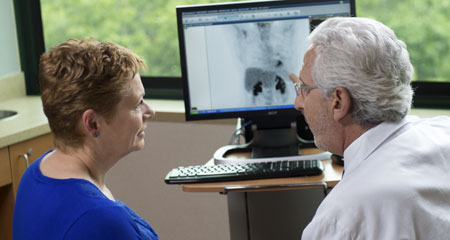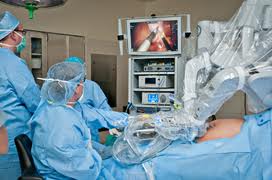
Gallbladder cancer is very uncommon. Women are more likely to have gall bladder cancer than men. The risk increases with increasing age. It is more common in patients who have stones in the gall bladder, the risk being about 1%. Other diseases of the gall bladder, such as, porcelain (calcified) gallbladder, choledochal (bile duct) cyst and chronic gallbladder infection also increase the risk of gall bladder cancer.
It's not clear what causes gallbladder cancer. Most gallbladder cancer begins in the cells that line the inner surface of the gallbladder and is called as adenocarcinoma. Gall bladder cancer tends to spread to nearby organs and tissues such as the liver, bile ducts or small intestine. It also spreads to lymph nodes in the region of the liver. Ultimately, distant organs and lymph nodes can become involved.
Gallbladder cancer is difficult to diagnose because it often causes no signs or symptoms. When present, the symptoms may be non-specific and similar to many other chronic diseases. The relatively hidden nature of the gallbladder probably makes it easier for gallbladder cancer to grow without being detected.
Jaundice (yellowing of the skin and whites of the eyes), itching, bloating, abdominal pain, weight loss, decreasing appetite, fever, nausea & vomiting or an enlarging abdominal mass are all signs that may be attributable to gall bladder cancer. Frequently, jaundice is a late development and the other symptoms have been present for a long time. Sometimes, it is detected incidentally on the biopsy after cholecystectomy (gallbladder removal operation) for gallstone disease. When diagnosed in this situation, it is generally at a very early stage and the chance for cure is very good.
The following stages are used for gallbladder cancer :
• Stage 0 (carcinoma in Situ) : Abnormal cells are found in the inner (mucosal) layer of the gallbladder; these abnormal cells may become cancer and spread into nearby normal tissue
• Stage I : Cancer has formed and has spread beyond the inner (mucosal) layer to a layer of tissue with blood vessels or to the muscle layer
• Stage II : Cancer has spread beyond the muscle layer to the connective tissue around the muscle.
• Stage IIIA : Cancer has spread through the thin layers of tissue that cover the gallbladder and/or to the liver and/or to one nearby organ (eg, stomach, small intestine, colon, pancreas, or bile ducts outside the liver)
• Stage IIIB : Cancer has spread to nearby lymph nodes and [#Section_218] beyond the inner layer of the gallbladder to a layer of tissue with blood vessels or to the muscle layer; or beyond the muscle layer to the connective tissue around the muscle; or through the thin layers of tissue that cover the gallbladder and/or to the liver and/or to one nearby organ
• Stage IVA : Cancer has spread to a main blood vessel of the liver or to 2 or more nearby organs or areas other than the liver. Cancer may have spread to nearby lymph nodes.
• Stage IVB : Cancer has spread to either lymph nodes along large arteries in the abdomen and/or near the lower part of the backbone or to organs or areas far away from the gallbladder.

• Physical Examination and History
• Liver Function Tests
• Carcinoembryonic Antigen (CEA) Assay
• CT Scan (CAT Scan)
• Ultrasound Exam
• PTC (Percutaneous Transhepatic Cholangiography)
• ERCP (Endoscopic Retrograde Cholangiopancreatography)
• Biopsy
• Laparoscopy

Surgery, chemotherapy and radiotherapy are all used to treat gallbladder cancer. Many patients get a combination of treatments. For example, chemotherapy or radiotherapy can be used to shrink the tumour before surgery.
Your treatment will depend on the stage, grade and type of cancer cells you have. The stage looks at the size of your cancer and if it has spread from where it started. The grade of the cancer can tell if your cancer grows quickly or slowly. You can have a low, moderate or high grade cancer.
Surgery
Surgery offers the best chance of curing early-stage cancer that has not spread beyond the gallbladder. To determine if surgery is possible, surgical oncologist at DHRC may order images of the gallbladder, bile ducts and the liver. Surgeons will use a camera and miniature instruments inserted through tiny incisions in the abdomen (laparoscopic surgery) to see if the tumor has spread (metastasized). Surgery options include: .
• Simple cholecystectomy
If the tumor is very small and has not spread to the deeper layers of gallbladder tissue, the surgeon may use this procedure, which removes only the gallbladder. Occasionally this procedure can be done using laparoscopic surgery.• Extended cholecystectomy. This is the most commonly performed surgery, involving removal of the gallbladder, the liver tissue next to it, and nearby lymph nodes.
• Chemotherapy When the cancer has spread to other organs, medical oncologists may recommend chemotherapy.
• Chemotherapy currently does not cure advanced gallbladder cancer, but sometimes slows the disease's progression.
Radiotherapy treats cancer by using high-energy x-rays that destroy the cancer cells while doing as little harm as possible to normal cells. It is occasionally used for cancer of the gall bladder. It can either be given externally
from a radiotherapy machine or internally by placing radioactive material close to the tumour (brachytherapy).
Single-Site da Vinci Surgery gallbladder cancer hospitals indiais minimally invasive – performed through a single small incision using state-of-the-art technology. This procedure is performed using the da Vinci Surgical System. da Vinci is a state-of-the-art robotic surgical platform that translates your surgeon’s hand movements into smaller, more precise movements of instruments inside your body. da Vinci’s vision system provides your surgeon with 3D-HD visualization allowing for enhanced vision, precision, dexterity and control. During the entire procedure, your surgeon is 100% in control of the da Vinci System.
You may want to ask some questions before your treatment begins:

Mr.Gilbert, Knee Replacement, Nigeria
Mr.Gilbert from Aba, Nigeria who came to India for his knee replacement in India.
Mrs. Kalangwa George, Lung Cancer, Kenya
Mrs. Kalangwa George from Mombasa, Kenya who came to India for her Lung Cancer Treatment in India.
Mrs. Elisabeth, Breast Cancer Surgery, Nigeria
Mrs. Elisabeth from Kano, Nigeria who came to India for the Breast Cancer Surgery.
Mr.Tselmeg, Kazakhstan, Spine Surgery
Mr.Tselmeg from Astana, Kazakhstan who came to India for the Spine Surgery
Mr. Stephen Okafor, Spine Surgery, Nigeria
Mr. Stephen Okafor from Onitsha, Nigeria who came to India for the Spine Surgery
Mrs. Asiata Nofiu, Laparoscopic Ovarian Cystectomy , Nigeria
Mrs. Asiata Nofiu from Lagos, Nigeria who came to India for the Laparoscopic Ovarian Cystectomy
Mr. Alhassan Osman, Prostate Treatment, Tanzania
Mr. Alhassan Osman from Mwanza, Tanzania who came to India for the Prostate Treatment
Mr. Okubowa Babatunde , Heart Surgery , Zimbabwe
Mr. Okubowa Babatunde from Harare, Zimbabwe who came to India for the heart hole surgery